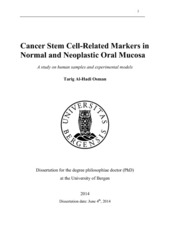| dc.contributor.author | Osman, Tarig Al-Hadi | en_US |
| dc.date.accessioned | 2014-06-17T15:00:03Z | |
| dc.date.available | 2014-06-17T15:00:03Z | |
| dc.date.issued | 2014-06-04 | eng |
| dc.identifier.isbn | 978-82-308-2889-2 | en_US |
| dc.identifier.uri | https://hdl.handle.net/1956/7976 | |
| dc.description.abstract | The existence of cancer stem cells (CSCs) in solid cancers is still a controversial issue. Several markers were successfully used to enrich for cells with stem cell-like properties in oral squamous cell carcinoma (OSCC). Among these, ALDH1 was reported in both OSCC and several other human cancers. The aim of this study was to investigate the pattern of expression of several CSC-related markers including ALDH1 and the normal oral keratinocyte stem cell marker p75NTR relative to each other in patient samples and OSCC-derived cells, and the potential of p75NTR to identify and isolate CSCs in OSCC. To simultaneously detect several CSC-related markers in patient samples, a multiple IHC protocol engaging three un-conjugated monoclonal primary antibodies from the same Ig subclass was first developed, based on previously reported protocols. Compared to other methods, stripping of the preceding reaction by microwave heating, combined with additional suppression of enzyme activity, has enabled specific detection of all three reactions by using the same detection system, with no detectable cross reactivity. Archival formalin-fixed paraffin embedded tissues from OSCC (n=177), oral dysplasia (OD, n=10), and normal human oral mucosa from healthy donors (NHOM, n=31) have been subjected to the developed multiple IHC protocol, while keratinocytes derived from OSCC, OD and NHOM were subjected to multiple fluorescent activated cell sorting (FACS). The findings of the two approaches showed a wider range of variability in the level of expression and localization of the CSCrelated markers in OSCC and OD as compared to NHOM. In addition, the data also indicated a functional difference between different cellular phenotypes positive for either p75NTR or ALDH1A1. Firstly, higher proliferation (Ki67) was observed in p75NTR+ cells in comparison to ALDH1+ or p75NTR+ALDH1+ cells. Secondly, the frequency of p75NTR+ cells was higher in OSCCs of small size (T1 & T2) and OSCCs with poor to moderate differentiation grade, and correlated with poor survival of patients clinically deemed as of better prognosis. High frequency of ALDH1+ cells was found to be associated with lymph node metastasis. No statistically significant association was found between any of the clinical variables investigated and the frequency of the co-localization of CSC-related markers. Thirdly, OSCC cells sorted for p75NTR and ALDH1 displayed different expression profile of several CSC-EMT related genes. OSCC-derived cells sorted for p75NTR expression were compared for stem cell properties using both in vivo and in vitro assays. Statistically significant higher stem cell properties were found for the p75NTRHigh cells than for the p75NTRLow cells in all assays performed. This suggested that p75NTR can be used for isolating a subpopulation enriched for cells with stem cell–like properties in OSCC. Nevertheless, the p75NTRLow subpopulation did also exhibit some stem cell features, but to a lesser extent. Propagation of p75NTRLow cells for several passages in culture showed that the expression of p75NTR could rise spontaneously. This finding was also supported by the similar expression of p75NTR by the xenografts generated by both subpopulations in NOD\SCID IL2R null mice. Similar spontaneous generation of ALDH1High cells by propagation of ALDH1Low cells was observed, although with a different kinetic. Taken together, the data from this study showed high inter-patient variability in the expression of the CSC markers investigated, and high intra-tumor heterogeneity of the CSC subpopulation. The results presented here suggest also that some OSCC might have several distinct CSC phenotypes, each with impact on different clinical aspects, while other OSCC might completely lack a hierarchical organization. De novo generation of p75NTRHigh or ALDH1High cells from their negative counterparts might indicate the existence of a dynamic equilibrium between cancer cells with different degrees of differentiation. | en_US |
| dc.language.iso | eng | eng |
| dc.publisher | The University of Bergen | eng |
| dc.relation.haspart | Paper I: Successful triple immunoenzymatic method employing primary antibodies from same species and same immunoglobulin subclass. T.A. Osman, G. Øijordbakken, D.E. Costea, A.C. Johannessen, European journal of histochemistry : EJH 2013; 57: e22. The article is available at: <a href="http://hdl.handle.net/1956/7975" target="blank">http://hdl.handle.net/1956/7975</a> | en_US |
| dc.relation.haspart | Paper II: Multiple Immunostaining Identifies Separate Cancer Stem Cell Subpopulations in Oral Squamous Cell Carcinoma Tarig A. Osman, Oddveig Rikardsen, Muy-Teck Teh, Dipak Sapkota, Xiao Liang, Evelyn Neppelberg, Adrian Biddle, Ian Mackenzie, Lars Uhlin-Hansen, Anne Ch. Johannessen, Daniela E. Costea. The article is not available in BORA. | en_US |
| dc.relation.haspart | Paper III: The low-affinity nerve growth factor receptor p75NTR identifies a transient stem cell-like state in oral squamous cell carcinoma cells. Tarig A. Osman, Himalaya Parajuli, Dipak Sapkota, Anne Ch. Johannessen, Daniela E. Costea. The article is available at: <a href="http://hdl.handle.net/1956/9058" target="blank">http://hdl.handle.net/1956/9058</a> | en_US |
| dc.title | Cancer Stem Cell-Related Markers in Normal and Neoplastic Oral Mucosa. A study on human samples and experimental models | en_US |
| dc.type | Doctoral thesis | |
| dc.rights.holder | Copyright the author. All rights reserved | |
